In bars, “top-shelf” refers to premium, higher-priced liquors, while “well drinks” (or “house drinks”) are made with the standard, more cost-effective liquors typically stored in the “well.” We can apply a similar scheme to which fuel we put into our motorcycles.
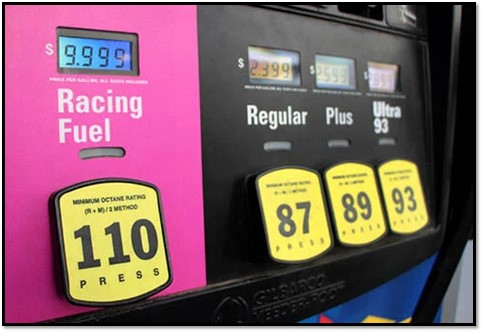
Wikipedia’s grossly oversimplified assertion that “high-octane fuel is of very good quality” is not incorrect, but it does not accurately define the difference between low- and high-octane fuel, leaving the reader with the misconception that higher octane is always better.
Firstly, race gas is for a racing engine, period. Common motorcycle engine compression ratios* typically range from around 9.5:1 to 12:1, with some higher-performance or racing engines reaching ratios of 14:1 or even higher. Many modern motorcycles, especially those designed for everyday use have engine compression ratios from 10:1 to 12:1. The Suzuki DR650SE has a 9.5:1 compression ratio; the 2024 BMW R 1250 GS Adventure I ride is 12.5:1; and the Ducati Panigale V4 has a 14:1 compression ratio.
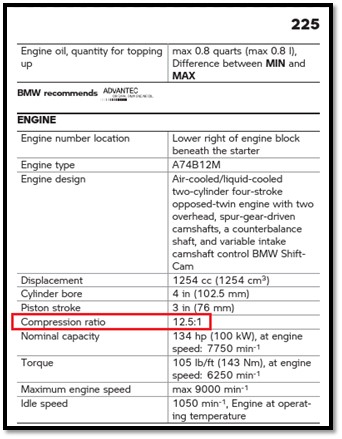
The problem with running super high-octane gas is that if you don’t have the compression to squeeze the air/fuel mixture enough, the result will be decreased performance and a higher potential of damaging your engine.
(* Ed.’s Note: The compression ratio is a mathematical expression comparing the maximum volume of a cylinder to its minimum volume—that is, how much space there is for fuel and air when the piston is at bottom dead center versus when it is at top dead center. Higher compression ratios typically denote higher performance, and some engines with high compression ratios require higher-octane gasoline for peak performance and to prevent knocking, which is the fuel-air mixture burning unevenly or incompletely.)
Despite what some people think, the octane rating is not a direct indication of a particular blend of fuel’s overall quality or power. According to the EPA, “Octane rating is the measure of a fuel’s ability to resist ‘knocking’ or ‘pinging’ during combustion, caused by the air/fuel mixture detonating prematurely in the engine.” That’s it. Every other label you see on premium gas, the “V-Power Nitro+ Wicked Mega Awesome” grade, is marketing hype intended to make you spend more money on a higher grade of fuel that you likely do not need.
In the United States and Canada, gasoline is typically available in three varieties: regular, mid-grade, and premium. The numbers appearing on the pump can vary depending on the method used to calculate them. In North America, we use what is known as the “(R+M)/2 method.” You might have seen this formula printed on the pump, as shown in the title picture.
The manufacturers of fuel use two tests to determine the octane number. The Research Octane Number (RON) is tested under engine idle conditions with a low air temperature and slow engine speed. The Motor Octane Number (MON) is tested under the more stressful conditions of higher air temperature and engine speed. The number you see on the pump is the number derived from each of these tests added together then divided by two to get an average. The (R+M)/2 formula means RON plus MON, divided by two. For our purposes, it’s safe to say that typically, regular gas is 87 octane, mid-grade is 89, and premium is 91 or 93.
When gas has more octane, it will burn cooler and slower, and more importantly, requires a higher compression to get that fuel to release its energy. Higher octane simply means a more controlled burn under higher pressure conditions, such as in high compression or high boost or turbo charged engines. If you use super high-octane fuel without the compression to support it, your engine will “ping.”
In piston engines, detonation, also known as “engine knock” or “pinging,” is an abnormal combustion event where the fuel-air mixture explodes rather than burns smoothly, causing a pounding force on the piston and potentially leading to engine damage. This can break piston tops, shred rings, blow head gaskets and cause other damage, all of which can be detrimental and expensive to repair. When gas becomes unstable in the burn stroke of a piston engine, it goes from a push on the piston top to a slam, like hitting it with a sledgehammer!
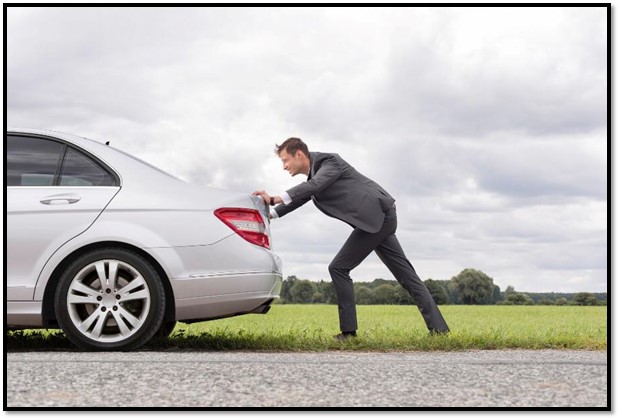

You hit it hard. In fact, much harder than you did by just pushing on it, and much harder than you could with just your hands. The car didn’t move, but you sure as heck just destroyed the trunk!
That is the difference between a controlled “push” and an out-of-control “slam” or “detonation.” This will likely cause irreparable damage to your engine. To keep higher compression race engines under control, a higher-octane fuel is used to keep that “push” from becoming an out-of-control sledgehammer hit. Without the higher compression, ultra-high octane (race) fuel doesn’t burn well.
The definitive answer as to what fuel you should run in your bike is to run whatever the manufacturer recommends. I can’t get away with the practice of using regular gas and BMW has good reasons to require premium fuel. Check the owner’s manual for your specific make, model, and year, and follow those recommendations.
Here’s the recommendations for mine along with my suggestion that you know your acronyms. In the United States, the “octane rating” displayed on gas pumps, also known as the Anti-Knock Index (AKI), is the average of the Research Octane Number (RON or ROZ) and Motor Octane Number (MON). The octane rating/octane number is a standard measure of a fuel’s ability to withstand compression in an internal combustion engine without causing engine knocking
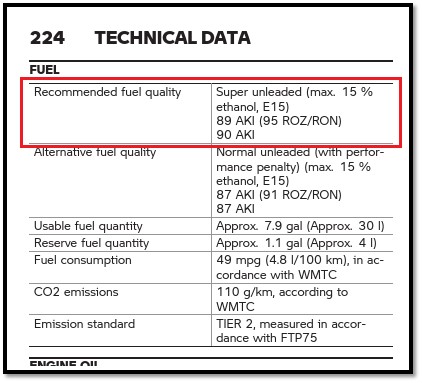
If you don’t have a copy of the owner’s manual for your bike, you should be able to look it up online. Be careful to follow the manufacturer’s actual recommendation, though, and not speculation from forums.
Top-Tier (Shelf) fuel is what most big-name retailers carry. Top Tier fuels contain a higher concentration of detergent additives—typically at least 2.5 times more at minimum for all grades of gas, with some station’s premium blend using seven times the required amount. These extra detergents and additives to their premium grades go beyond what is required, and these can have favorable effects on your engine.
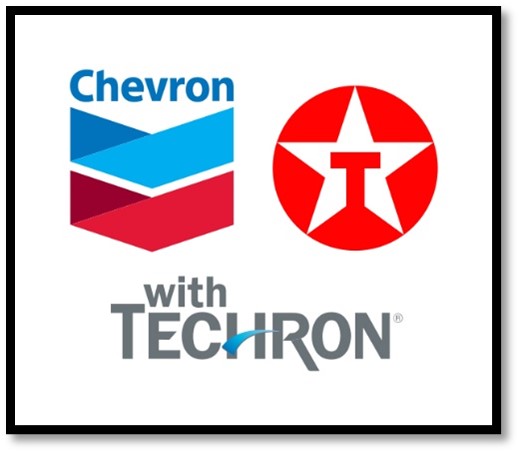
I and a lot of my fellow BMW owners choose to use premium Chevron or Texaco fuels. Techron is a fuel additive designed to clean deposits from fuel injectors, carburetors, intake valves, and combustion chambers, helping to restore lost power, improve fuel economy, and minimize emissions.
If you want to reap the benefits of these detergent additives but your bike only requires regular gas, it is acceptable to run a tank of premium from time to time. You will not benefit from additional power or performance unless the engine is specifically tuned to take advantage of higher-octane fuel, but if you like the idea of running premium’s extra additives through your engine occasionally, it’s probably okay.

From time to time, if your bike requires premium fuel, you may find yourself in a situation where that fuel is not available from the pump. I have run into this myself many times while exploring Alaska and western Canada. As avid adventure riders, we may find ourselves in far off places with extremely limited access to fuel of any kind—never mind the proper octane rating. Sometimes beggars can’t be choosers! The real question is what to do when low-octane fuel is all that was available, especially in higher elevations.
If you’re forced to use low octane fuel, there are some ways to make it easier on your machine. First, let the bike cool off from time to time in heavy, slow traffic. Second, be gentle on the throttle, like when accelerating away from traffic lights. In one instance of low-quality fueling, I put my BMW into “Rain Mode” to do just that. Finally, be smooth and gradual when overtaking other traffic.
These techniques are also helpful on modern fuel-injected bikes. The electronics will detect engine knocking and change the air/fuel mixture to avoid it, though at the cost of performance. It’s not ideal to run lower octane fuel than recommended, but if you absolutely must, try to keep the engine load and RPMs as low as possible. Basically, don’t ask too much of the engine until you can get the proper grade fuel in the tank.
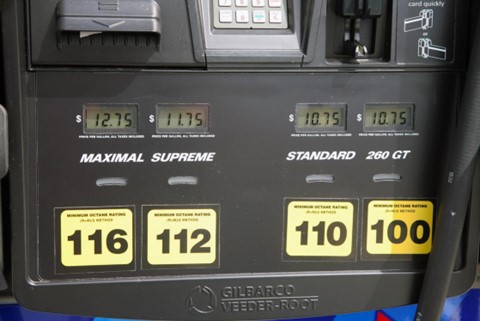
Racing fuel—100 octane or above—is expensive, and I’d rather not pay more than needed to gas up. The trade-off for this expensive fuel will not benefit you with increased performance or higher mileage—indeed, it could instead cause disastrous damage to your faithful steed. Reciprocating piston engines are designed and rigorously tested with a specific compression ratio that indicates a fuel octane level for best performance.
Simply put, using the appropriate fuel octane rating, as recommended by your vehicle manufacturer, is vital for optimal engine performance, fuel efficiency and engine longevity.
The correct octane rating is crucial to prevent engine damage, as using a lower (or higher) octane than recommended can lead to knocking or pinging, while using a higher octane than needed just wastes money. Check your owner’s manual or consult with your maintenance provider.
If you frequent the nearest quickie mart for discount regular gas, the occasional tank of premium from a name-brand, Top Tier retailer may do your engine some good. But remember that extra octane does not mean more power or performance. Unless your engine has been modified to take advantage of an ultra-high-octane fuel, absolutely stay away from racing fuel over 100 octane. However, premium 91 or 93 octane gas typically has a higher concentration of detergents, keeping your engine cleaner, which in the long run will help sustain power, mileage and throttle response.
